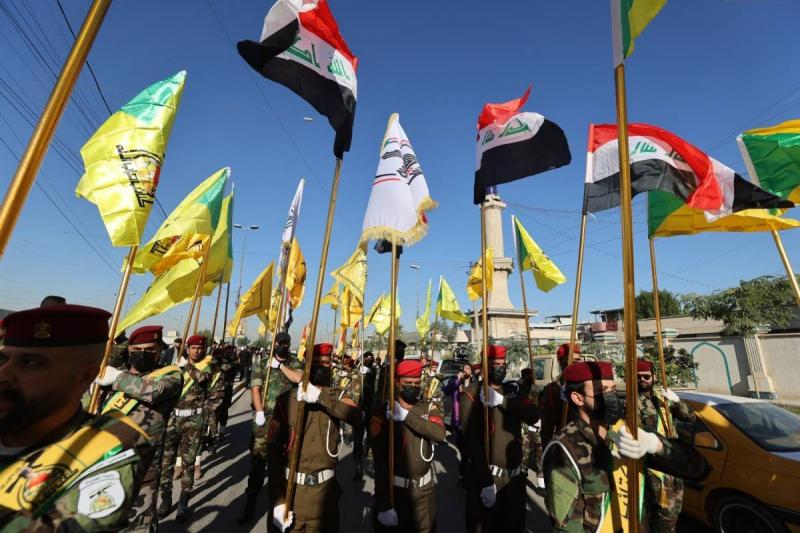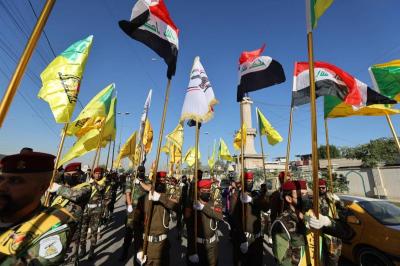The "Nujaba" Movement, one of the factions of the "Popular Mobilization Forces" in Iraq, suffered a significant blow a few days ago when a drone strike hit one of its headquarters in Baghdad, resulting in the death of its leader Mushtaq Taleb Ali Al-Sayidi. What is this movement, and what weight does the victim, nicknamed "Abu Taqwa," carry?
The strike, which led to "Abu Taqwa's" death, coincides with the fourth anniversary of the killing of "Al-Muhandis" and the commander of the Quds Force in the Iranian Revolutionary Guard, Qassem Soleimani, by an American strike near Baghdad Airport in 2020. This event follows a series of attacks carried out by Iranian-backed militias against U.S. forces in Iraq and northern and eastern Syria, reportedly in response to support for Gaza, which has been experiencing an ongoing war nearing its third month.
After the strike, a Pentagon official stated that the United States "continues to take measures to protect its forces in Iraq and Syria, addressing the threats they face." The Iraqi Cabinet blamed the international coalition for the "unjustified" attack on an Iraqi security entity, describing it as a "serious escalation and aggression against Iraq." Moreover, an American official told Reuters that the "U.S. military conducted a strike in Baghdad against a leader of an Iraqi armed faction accused by the U.S. of responsibility for attacks against its forces in Iraq, resulting in his death and that of another individual." The American official, who spoke on condition of anonymity, indicated that the strike targeted a vehicle in Baghdad, resulting in the death of a leader from the "Nujaba" Movement.
### Who is Al-Sayidi?
Al-Sayidi held the position of "Deputy Commander of Baghdad Belt Operations," and although he is part of the "Nujaba" Movement, Iraqi researcher on armed groups, Raed Al-Hamid, clarifies that his significance is more closely tied to the "Popular Mobilization Forces." "Abu Taqwa" played a significant security role in the Tarmiya area and its surroundings and led attacks attributed to what is called "Islamic Resistance in Iraq," being one of the close associates of "Al-Muhandis."
The "belt" related to his position encompasses the areas surrounding the center of the Iraqi capital, extending approximately 40 kilometers outward. Al-Hamid explains that the northern belt includes Tarmiya, Al-Mushahda, and Al-Rashidiya, while the southern belt includes Yusfiya, Al-Iskandariyah, Al-Mahmoudiyah, and Al-Latifiya, with Abu Ghraib to the west and Madaen to the east.
### "Transnational Beyond Iraq's Borders"
The "Nujaba" Movement, to which Al-Sayidi belongs, is considered one of the most prominent factions connected to Iran in Iraq. In March 2019, the U.S. designated it as a "terrorist organization." Al-Hamid notes that its "ideology is transnational" and that it "pledged allegiance to Iranian Supreme Leader Khamenei in 2014 after the formation of the Popular Mobilization Forces via a fatwa from Sistani." Its armament is particularly linked to missiles and offensive drones, and it is associated with the "Ahl Al-Kahf" group, which has frequently attacked U.S. forces in Iraq.
An analytical paper from the "Washington Institute" indicates a "strong conviction" that the "Nujaba" are affiliated with the Quds Force in the Iranian Revolutionary Guard and receive partial funding from it. Most evidence, according to the institute, shows that Iran provides financial and military assistance to the movement, shares intelligence, helps in leadership selection, and oversees its operations.
Since its inception in 2013, the "Nujaba" has revolved around the personality and power base of Akram Al-Kaabi, its military leader, who was listed by the U.S. Treasury in 2008 as a "specially designated global terrorist." It has also particularly focused on military operations in Syria during the transition of the movement there from peaceful to armed.
Numerous reports from both Syrian and Iraqi sources confirm that Al-Kaabi, who established the "Nujaba" after shifting to support Assad's regime, participated in numerous military operations, notably those in Aleppo and its countryside, where they resulted in breaking the siege of the towns of Nubl and Al-Zahra. His troops routinely published recorded videos documenting their battles alongside Assad’s forces, including footage that featured Qassem Soleimani's name written on rockets before they were fired at civilians in Syria.
### "An Example of Iran's Goals"
A Reuters report published in 2017 pointed out that the "Nujaba" exemplifies Iran's attempt to expand Shiite influence in Iraq and the region. The report added, citing sources, that "militia members who receive training are sent directly to Damascus from Baghdad or Najaf," while others train with "Hezbollah" in Lebanon after crossing land routes from Iraq to Syria via Al-Bukamal.
Al-Hamid clarifies that the "Nujaba" are organizationally connected to the Lebanese "Hezbollah," akin to "Hezbollah Brigades" in Iraq, which have faced two strikes from the U.S. in response to the group's attacks in Syria and Iraq. He notes that the movement is "the only faction not participating in the government and parliament in Iraq."
In 2017, the movement announced the formation of the "Golan Liberation Brigade," stating its mission was "to support the Syrian Arab Army in liberating its occupied territories and lifting injustice from the Syrian people." However, no qualitative operations or areas of deployment for this "Brigade" were announced, even though the movement has claimed several attacks on U.S. forces in Syria and Iraq since October 17 and other strikes allegedly targeting Eilat in southern Israel.
Nonetheless, Al-Hamid confirms that movement fighters remain present within Syrian territory, specifically in the Damascus countryside, Quneitra, and Al-Bukamal, as well as on the Iraqi side in Al-Qaim, Mosul, and northern Baghdad.
### "The Largest Factions of the Mobilization Forces"
In Iraq, the "Nujaba" Movement manages the 12th Brigade of the "Popular Mobilization Forces" and is considered one of its largest military components, with their numbers ranging from 8,000 to 10,000 fighters, according to Reuters, with about 500 killed in Syria and Iraq by 2017. Iran had extended a high-level visit invitation to its leader Al-Kaabi after his forces spearheaded the control of the Syrian city of Aleppo.
Reuters reports that he met in 2017 with senior Iranian officials, including Parliament Speaker Ali Larijani, former commander of the "Revolutionary Guard" Mohsen Rezaei, and Iranian Supreme Leader Ali Khamenei. Al-Kaabi has several photos with the leader of Lebanese "Hezbollah," Hassan Nasrallah, as well as images of him in military attire alongside the former commander of the Quds Force, Qassem Soleimani.
Before forming the "Nujaba," he was one of the founders of the "Mahdi Army" led by Iraqi cleric Muqtada Al-Sadr, before splitting off to later play a role in establishing the "Asa'ib Ahl Al-Haq" group, which carried out military operations against American forces. According to Iraqi officials, Iran pays approximately $1,500 for each fighter in the "Nujaba" Movement, and following Soleimani's killing in the American strike on January 3, 2020, its leader Al-Kaabi joined other militia leaders "to avenge the Quds Force commander." He has since re-emerged as a figure of interest with the escalation of attacks against American forces from October 17, within what has come to be known as the "Islamic Resistance in Iraq," to which all strikes attributed in both Syria and Iraq belong.




